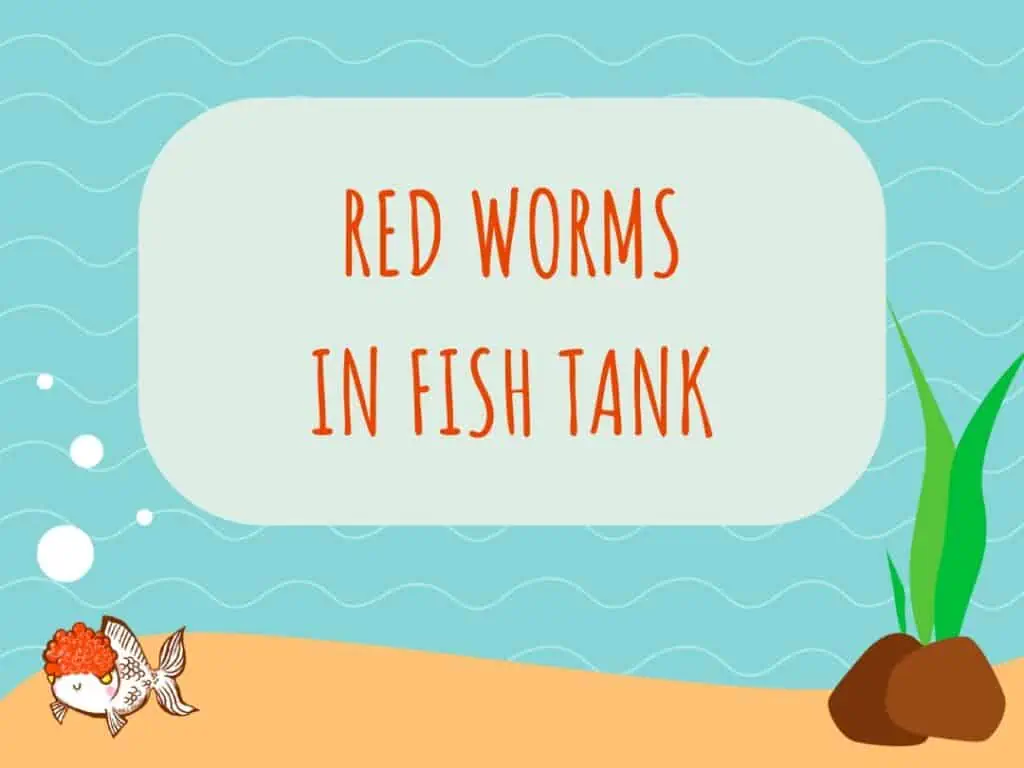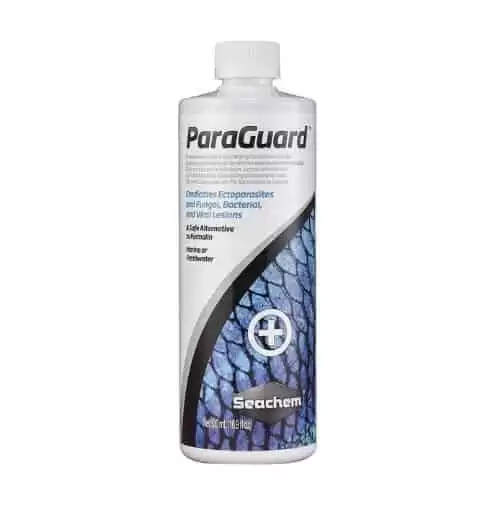You went to feed your fish their breakfast in your beautiful fish tank and spotted a thin, red thread poking out of your fish’s rear end! OMG! What is that?!
The chances are that your fish has contracted a Camallanus infection.
But what is Camallanus? Are they contagious? And how can aquarium owners treat and prevent these dangerous intestinal parasites?
Read this guide to learn more about Camallanus worms and how to protect your fish.
What Are Camallanus Worms?
Camallanus are tiny internal parasites that can attack many freshwater aquarium and wild fish species. Coldwater and tropical fish are both at risk from these parasites.
There are lots of nematodes and roundworms belonging to the Camallanus genus that can attack your fish. The parasites attach themselves to the fish’s intestinal wall, often co-existing with the host for many months without causing any obvious problems.
However, the fish can suffer from weakened immune systems in a tank with poor water conditions or a community where aggression and bullying are a problem. That weakness allows Camallanus to attack the fish, potentially causing serious damage or even death to your pets.
Mature Camallanus worms are red because they feed on the host’s blood. As well as depriving the infected fish of nutrients, the worms irritate the digestive tract and its adjacent organs, often causing secondary bacterial infections and internal bleeding.
Appearance
Camallanus worms can vary in size, depending on the species and the age of the parasites.
In some species, the worms can measure up to 2 millimeters long. Most worms have elongated, slim bodies without legs or hooks. Unlike tapeworms, which are flat, roundworms are cylindrical, tunneling through the fish’s soft tissues, causing both external and internal injuries and damage.
Species of Camallanus Worms
There are lots of Cammallanus worm species, some of which specialize in only attacking specific fish species.
The North American parasite species, Camallanus oxycephalus is often seen in wild fish, such as bass, sunfish, and shiners, while the South Asian species, Camallanus anabantis, is found in gouramis and barbs, among others.
However, the East Asian species, Camallanus cotti, is the type that’s most often responsible for attacking aquarium fish of multiple species, including livebearers, cichlids, gobies, rainbowfish, and labyrinth fishes.
Do My Fish Have Camallanus Worms?
At first, your fish look perfectly fine, going about their usual daily behavior with no signs of trouble.
Then you could notice juvenile fish growing slowly, or adult fish might not spawn as readily. All your fish could show behavioral changes, such as a lack of appetite or lower activity levels. As the disease progresses, you might find a few dead fish in your tank, although that can take quite a few months.
Red Threadlike Clusters
Those symptoms could be associated with many fish diseases, but there’s one dead giveaway that immediately confirms that Camallanus worms are the culprits. If you see tiny red worms emerging in a threadlike cluster from the fish’s anal vent, you can be pretty sure that you have a Camallanus infestation in your tank.
Once the disease reaches this advanced stage, your fish often look emaciated because the worms are taking all the nutrients your fish ingest, or the fish’s belly might be swollen with worms.
Often, secondary infections occur because the worms obstruct the fish’s intestines.
Size Matters
Small nano fish, such as guppies and danios, often get sick more quickly than larger species. That’s simply because it takes very few red worms to cause serious problems in tiny fish.
The Camallanus Worm Life Cycle
Camallanus worms have a relatively complex life cycle:
- A free-living phase
- A number of molts when the worms infect a crustacean or intermediate host
- A further molt that happens inside the final fish host
Once the parasite mates, mature female worms kick off the life cycle by producing vast quantities of first-stage larvae, which are carried out into the water column and eventually settle on the substrate.
The wriggling larvae attract small crustaceans that eat them. Once inside the temporary host, the worms feed and grow. Interestingly, brine shrimp (Artemia) don’t host Camallanus worms because they are raised in salty environments that the worms can’t tolerate.
After a week or so, the larvae molt twice, morphing into inactive third-stage larvae that remain inside their host. If a fish eats the crustacean, the third-stage larvae become active and begin to feed again.
Eventually, the larvae molt twice more, becoming sexually mature female or male adult worms, and these are the red worms you see poking out of your fish’s anal vent.
How Long Does the Camallanus Life Cycle Take To Complete?
The duration of the Camallanus life cycle depends on the temperature and varies between species. However, in the case of Camallanus cotti, the life cycle can be complete within a month if the water temperature remains around 77o F.
Although a few Camallanus species cannot complete the life cycle unless they find an intermediate host, some, including Camallanus cotti, can skip that stage.
Mature female parasites of this species can infect fish directly in the absence of a suitable crustacean host first.
How Did My Fish Get Camallanus Worms?
Sometimes, Camallanus can be passed between fish by ingesting fish feces from infected animals or the host eating a dead fish.
The parasites can find their way into your aquarium inside infected fish. The host fish passes out worm larvae in its feces, which are then eaten by your cleaning crew, such as cyclops. Your fish eats the infected crustacean, becomes infected, and the Camallanus life cycle continues.
The disease is pretty contagious, so if you add plants, substrate, or aquarium equipment from an infected tank, you can easily accidentally bring the parasite into your clean aquarium.
How To Treat Camallanus Worms
Fortunately, treating Camallanus worms is fairly straightforward. You can use a dewormer, such as Seachem Paraguard, to kill the parasites. Be sure to follow the manufacturer’s instructions carefully, and don’t overdose your tank.
- Eradicates ectoparasites and fungal, bacterial, and viral lesions
- Safer to dose than formaldehyde, formalin, and methanol
- Will not adversely effect bio-filter
Paralyzed
Note that many antiparasitic medications don’t kill the worms but merely paralyze them. So, you’ll need to read the directions on the packaging to determine the drug’s effect.
Since Camallanus worms are so contagious and easily spread, we recommend that you treat the whole tank rather than trying to isolate individual fish and shrimp in a quarantine tank.
Following treatment, the fish should pass the paralyzed and dead worms and larvae in their feces. After 24 hours, use an aquarium siphon vacuum cleaner to remove the fish waste and dead worms from the tank and perform a 25% water change.
It’s worth treating the tank again two weeks after the initial treatment to ensure you get rid of any remaining worms that might have hatched.
To deal with any secondary infections that might affect your fish, we suggest you also use a broad-spectrum antibiotic or antifungal medication.
Promote a Good Recovery
A parasite infestation can be extremely debilitating for your fish, so you’ll need to take steps to help your pets recover once you’ve treated the infection.
Ensure the environment is as stress-free as possible, and maintain excellent, clean water quality by frequently vacuuming the tank and performing partial water changes. Feed your fish a diet of high-quality foods to help them regain any weight they’ve lost.
We also recommend you disinfect your nets, siphon, and other equipment to prevent the spread of the disease.
How To Prevent Camallanus Worms
Fortunately, Camallanus worms are quite easy to prevent.
Quarantine
We strongly recommend that you place all new fish, plants, and old substrate in a quarantine tank for at least a month before adding them to your main display tank.
During that time, it can be worth treating your fish with anti-parasite and anti-bacterial medication to ward off infections.
Most fish will cope with red worms for a while before problems start, so ensure that you keep stress levels in the tank low, feed high-quality foods, and maintain excellent water quality in the tank.
Avoid Cross-Contamination
It’s essential that you avoid cross-contamination by washing your hands after touching your quarantine tank and using different siphons, nets, etc., for treating fish in quarantine.
FAQs
In this part of our guide to red worms in your fish tank, we answer a few of the most commonly asked questions about them.
Q: Why Are There Red Worms in My Fish Tank?
A: Red worms are the adult form of a parasite called Camallanus. There are various species of Camallanus, some of which can attack freshwater aquarium fish.
These parasites get into your fish tank via infected crustaceans, infected fish, and sometimes as eggs amongst substrate from an infected tank.
Q: How Do I Get Rid of Red Worms in My Fish Tank?
A: The best way to get rid of red worms in your fish tank is to treat the whole tank with an anti-parasitic medication, such as Seachem Paraguard.
It’s important to know that many of the medications that will deal with these worms and their larvae don’t actually kill the parasites but paralyze them. So, when your fish poop, the paralyzed worms are ejected into your tank.
It’s essential, therefore, that you immediately remove all fish waste and worms with an aquarium gravel vacuum cleaner. As part of that process, you should carry out a partial water change of around 25% to refresh the tank.
As you should with all fish medications, water conditioners, etc., be sure to read and follow the manufacturer’s directions carefully and never overdose your tank.
Q: What Are the Little Pink Worms in My Fish Tank?
A: If you see any little pink worms moving in your tank, it’s likely that they are either some species of detritus worms or planaria.
Neither of these worms is especially harmful to your fish, but they can cause damage to shrimplets and fry if present in large numbers. That said, you don’t want these critters cruising your tank.
Q: Are Camallanus Worms Harmful?
A: Camallanus are parasitic worms that are extremely harmful to your fish. Once inside the host fish, the worms burrow into the creature’s intestine, where they feed on your fish’s blood.
As a result of Camallanus worm activity, the fish loses valuable nutrients and is exposed to the risk of secondary bacterial infections. Ultimately, your fish will probably die unless you manage to kill the worms first.
Final Thoughts
I hope you enjoyed our guide to identifying, treating, and preventing the red worms you sometimes see in your fish tank. If you found the article helpful, please share it with other aquarists before you go.
Camallanus worms are nasty parasites that get into your fish to feed off its blood. As a result, the fish loses condition, becomes weakened, and often succumbs to secondary bacterial infections.
The worms find their way into your aquarium inside tiny crustaceans, as passengers inside infected fish, or sometimes as eggs on plants or in the water in a fish bag.
You can prevent Camallanus from attacking your fish by keeping your tank in pristine condition and offering your fish a high-quality, appropriate diet so that they are healthy and strong.
All new fish, plants, and substrate imported from an existing tank must be placed in a quarantine tank for a few weeks before introducing them to your main display tank.
Luckily, red worms can be treated by using an over-the-counter anti-parasitic product as soon as you spot the problem.



